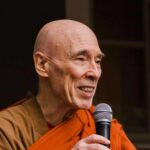
Sulak Sivaraksa
Yokohama, Japan
10 November 2012
?
?
The foundation of all Buddhist practice, and without which there is no Buddhist practice, is sila (ethics which means how to be normal and natural without exploiting ourself and others). Ethics, in Buddhism, begins with the understanding that we are not just observers in reality. Whether we like it or not, we participate, with our bodies, our speech, and our minds. Certain behaviors of body, speech, and mind are injurious, whether in solitude or with others. They lead to our own unhappiness, to conflict, and to the suffering of others. Much the suffering that human beings inflict on others is within our control. What mental processes give rise to human-made conflict, misery, and suffering? What behaviors of body, speech, and mind bring benefit : greater peace, happiness, and relaxation, and also greater harmony with others? This empirical, rational, pragmatic approach is the foundation of Buddhist ethics.
For contemplatives who follow the Buddhist path to become buddhas themselves, rather than merely studying Buddhism, ethics takes on the further meaning of refining the mind. It becomes part of their contemplative technology (samadhi). In the west, one problem with introspection, which has had a very short lifespan within the scientific context, is that the tool used was very poorly trained. The ordinary mind that oscillates between excited agitation and dull laxity is not a good instrument for making observations. This problem was recognized by the Buddha, who adopted existing techniques, brought them into Buddhism, and applied them in uniquely Buddhist ways. Adam Curle, a leading English Quaker felt that western meditation lacks methodology to analyse the mind appropriately. Without ethics?if you are behaving out of anger, craving, or delusion, and thereby reinforcing these mental afflictions?meditation can make no progress. Zen at War by Brian Victoria demonstrates clearly that Japanese warrior with a lot of zazen can kill more skillfully. With proper mindfulness you need sila side by side. A very fine sense of ethics is necessary for developing this contemplative technology of a mind that can enable you to make careful, precise, and deep investigations (praj??).
The final phase of Buddhist practice is the cultivation of insight, where you explore the world as it exists, not independently of experience and consciousness, but rather the world of experience called in Sanskrit loka. The strategy for this begins with trying to discover the nature of the objects of consciousness, the objects of mind.
Before investigating the rest of reality, you have to examine the tool that is the mind. Scientists waited three hundred years before examining this tool, and there?s still no science of consciousness. How can you have a science of consciousness when you have no scientific means of exploring the nature of consciousness?
The scientific community is like a living organism. Science in 2012 is not the same as the science of 1812 or 1612. Like a marvelous living organism, science has been drawing in nutrients, excreting waste products, and mutating in various unexpected ways through history, economics, war, and a myriad other influences. It evolves but maintains its integrity. It has never stopped being science. It?s growing now and it seems quite healthy.
The power and knowledge of science is so great that if it is used with hatred or malice, it could destroy humanity. Science urgently needs to absorb the nutrients of greater wisdom and compassion for its own self-preservation, if for no other reason.
Buddhism is also like a living organism that has evolved. We do not practice exactly the same Buddhism now that the Buddha revealed 2600 years ago, but there is a coherent identity. You can recognize that this really is Buddhism. Traditional Asian forms of Buddhism have now entered the very different environment of the modern world. How do we preserve its integrity? It has to adapt, but if it adapts too much, the organism dies and is replaced by little fragments. It could become little more than a therapy, helpful but very far removed from what the Buddha had in mind. On the other hand, if we try to preserve too much, it will also die. If it is seen as irrelevant, no one will feed it.
Both of these living organisms have to adapt. If science does not adapt, it may destroy all of us. If Buddhism does not adapt, it may just die. But the two may come together in a form of symbiotic mutation. They already share four basic elements of empiricism, rationalism, pragmatism, and skepticism. Maybe emergent properties will arise, new ways of inquiry that preserve both scientific and Buddhist values.
If we take Buddhism as a science of mind, we need to understand the importance of the notion of consciousness.
A gross level of consciousness, such as visual perception, is contingent upon the body and depends on the mechanisms of the retina and the visual cortex , as well as on the objective referent, whether that is photons or the object that you are seeing. But in the midst of the visual perception there is the very element of awareness, which the Tibetan called rigpa. This is luminous experiential component, the cognizant component of visual perception, or of knowing. We are speaking now of a subtler level, which does not arise from the visual faculty or from the objective referent. It arises only from a previous continuum of consciousness.
There is used to be a wide gap between the Western and Buddhist views of consciousness. Nowadays Western philosophers have good reasons to criticize very strongly the idea that consciousness is an emergent property of a complex chunk of matter. One is that science, by its very method, is unable to grasp what consciousness is. In order to make good predictions, science has to exclude everything that is not common to everybody. For instance, when science speaks about heat, it excludes the felt quality of heat and only retains what can be measured with a thermomet
er and shared on a piece of paper. Since it excludes felt quality from the outset, present methods allow no possibility of explaining them. A second reason is that consciousness cannot be called a property, nor even a phenomenon. A property is something objective, some thing detached from us, which is attributed to an object, whereas consciousness obviously cannot be detached from itself. Likewise, consciousness is not something that can be considered a phenomenon. Rather, it is phenomenality by itself. For these two reasons at least, and there are many others, many philosophers nowadays think that consciousness must be considered primary, and not derived from anything else.
The Dalai Lama explained that Even in Buddhism there is an implicit recognition of the difficulty of identifying what consciousness is. Although we are aware that consciousness exists, when we try to define it, it becomes very nebulous and difficult to pinpoint. But in principle, Buddhism maintains that it is possible to recognize experientially what consciousness is and identify it. There is an understanding, for example, that a highly advanced practitioner at the point of death can identify something called the ?clear light of death,? which is regarded as the subtlest experience of consciousness.
His Holiness continues In the Buddhist view, the difference between the animal realm and the human lies more in the level of intelligence. As for subtle consciousness, there is no difference between animal and human beings. Any sentient being that has the capacity to experience pain and pleasure is thought to possess this subtle consciousness.
There are different modes of meditation within Tibetan Buddhism, different avenues to that experience. In the cultivation of samadhi, for instance, you train in highly refining and developing the mind to such a degree of subtleness, clarity, and stillness that you can penetrate through the turbulence of your gross human mind, with all of its sensory perceptions and all of its cogitations. You settle your rapidly churning mind so that it becomes transparent, and then you tap into an underlying core of memory, including memories of previous lives that lend themselves to objective corroboration.
There is another mode of meditation within Tibetan Buddhism, called Dzogchen, where you do not necessarily have to achieve a deep state of samadhi, but you let your awareness come to rest in a very subtle way, where again the turbulence of the gross mind is calmed. Occasionally during this state something arises, like a bubble coming out of water, where one remembers a previous life, or a hundred lives, just like that even as far back as the Buddha?s time, or before that. I have not had that kind of experience, but some of my friends have.
It is important to understand the relation between a correct perception of reality.
?

When we analyze reality, we have a tendency to solidify or reify phenomena. Although we know that things are impermanent, that they are always flowing, that nothing remains identical to itself even for two consecutive moments, yet we have this tendency to perceive that yesterday?s table is today?s table, that the person we meet today is more or less the same person as yesterday. Even more deeply, although we know that we change from youth to old age, we think there is something constant is me. Instead of seeing the fluidity of phenomena, whether external or within our minds, we grasp them as being solid. What was fluid water now becomes ice.
What are the consequences of that? Instead of perceiving the intimate interdependence of constantly changing phenomena and understanding that nothing can happen except through relationship, we instinctively try to ascribe intrinsic properties to things. The first great divide, of course, is between self and others. What is in truth completely interconnected becomes two worlds : me and all the rest of the world. Then form ?me? comes ?mine?: ?This is mine ; that is not mine?—my relatives, my belongings. Then we start to ascribe properties to things and people. We say, ?This is beautiful.? Somehow we cannot help but feel that this beauty, or that pleasant aspect, intrinsically belongs to this person or that object. Little by little, we solidify, crystalize, and divide everything as being pleasant, unpleasant, beautiful, ugly, delicious, disgusting, mine, others. We have passions, impulses attracting us to what is pleasant to me, what I like, what I want to attract, to get, to keep, to increase. And we have a tendency to repulse whatever causes fear or disgust or animosity, because we ascribe those feelings as intrinsic properties. This is a friend, this is an enemy; and both become solid identifications.
What comes next is a very big development. Our mind is invaded by a chain of thoughts that arises from those feelings of attraction and repulsion. Attraction becomes a strong craving, an obsession, a desire that completely invades our minds. We feel pride and superiority when our self relates to others we consider inferior. We feel jealousy when something we consider ours is taken away. We feel animosity, wanting to destroy or harm, what seems threatening to us or goes against our desires. We lack discernment because we are blinded by this host of emotions and toxic mental events. We can?t discern with correct judgment, what needs to be accomplished and what needs to be avoided in order to fulfill our most intimate wish, the longing for happiness, and the longing that other beings have for happiness.
All these different metatoxins become the way our mind functions, to different degrees. Sometimes the mind is stronger than other times, but in the end all this leads to a deep feeling of frustration and suffering because the world will never match our desires. So there is a very close relation between our first misapprehension of the nature of phenomena—finding solid, intrinsic properties in an increasingly fragmented vision of the world—and suffering.
If you turn this around, you perceive interdependence. Instead of building reality out of separate, permanent, intrinsic qualities, there is a whole dynamic flow of relationship, constantly in transformation. It crystallizes in different ways under different conditions, according to your perception and so many other factors that you cannot isolate individual causes as pleasant or unpleasant. This vast net of interconnection is described in avatamaka sutra as a necklace of pearls on the palace of Indra, each pearl reflecting the whole palace. If you perceive things like that, then the whole process of solidification will not happen. You will naturally have the understanding that things are impermanent and changing,
that the enemy of yesterday can be the best friend of tomorrow, that what seems beautiful to someone seems ugly to someone else, that you yourself are changing from one minute to the next.
You will also see that there is no such thing as the constant entity you perceive within yourself, the ?me,? if you really analyze it. In this stream of constantly changing consciousness, there is no permanent entity that is the self. In realizing this, instead of losing what you might feel is the most precious thing in yourself, the ?me,? you are not losing anything. You are just unmasking an impostor. It is not the most precious thing in your being, but rather , it is what ties you to suffering.
Realizing the interdependence and the dynamic flow gives you freedom. You are no longer driven by the mechanism of taking and rejecting in the same way. There is no longer a reason for strong animosity to arise from identifying someone as truly, intrinsically an enemy. Ice and water are of the same basic nature. But the ice that comes from solidifying phenomena can cut. You can break your bones on it. If it melts, through inner freedom from the solidification of concepts, it is just fluid. It no longer threatens to harm your happiness. Losing the self does not mean becoming nothing; you simply untie the knots of solidified phenomena and gain inner freedom.
This also has a very intimate link with compassion. Compassion without interdependence means nothing. Our true nature is love. Imagine yourself suspended in space. If there were no interdependence with other beings, then there is no notion of love or compassion. Understanding interdependence makes you understand that your happiness comes through others? happiness. There is no way you can build you happiness at the cost of others? suffering. You might gain a temporary satisfaction at having defeated your enemy, but that will never be a lasting happiness.
For these reasons, a correct understanding of reality—the absence of any intrinsic nature of phenomena, and their interdependence—is said to be the ultimate view of the Buddhist teachings, referred to as wisdom. And this is intimately linked with compassion — like a bird?s two wings. A bird cannot fly with one wing. And you cannot ask which wing should start first. Both work together. You cannot start to fly with the right wing only and get to the left one later. You won?t fly very far that way. We have to keep wisdom and compassion in union all the time, from beginning to end, uniting understanding with ethical thoughts, words, and actions.
What I have said so far is infact the traditional art of happiness for oneself and others, but to rebuild our society and ensuring our future, we need to understand structural violence.
The term was coined by Johan Galtung, the Norwegian Buddhist and the founder of peace studies as an academic discipline. It refers to systematic ways a society?s resources are distributed unequally and unfairly, preventing people from meeting their basic needs. Structural violence includes elitism, ethnocentrism, classism, racism, nationalism, heterosexism, and ageism.
Structural violence may be political, repressive, economic, or exploitative. Unequal access to resources, power, education, health care, or legal standing are forms of structural violence. When inner-city children attend inadequate schools while others do not, when laborers work in inhumane conditions, structural violence exists.
Social structures are not permanent or natural phenomena. They evolve?through political and historical development?and usually refer to organizations, institutions, laws, and ideologies. Social structures influence action by creating frameworks of propriety that govern those within the structures.
Social structures pressure us to adopt desired dogma, establishing what is then regarded as normative. Each structure creates boundaries to what is acceptable, speakable, and thinkable. These boundaries define ?the truth.? They describe our worldview, and we accept it without question. We become spectators, even cheerleaders. When our mind gives rise to an idea that is ?outside the box,? we feel too afraid to seek the truth.
The power of social structures is enormous. They influence our thoughts, actions, attitudes, desires, and even our bodies. When we accept this canon, we enjoy a privileged status. When we challenge or reject it, we become marginalized. We have to see the relationships between social structures, self-surveillance, and self-censorship. To enforce social constructions, institutions intimidate us. Modern medicine fills us with the fear of illness, aging, and even ugliness. Religions might deceive us; Buddhist temples in my country have become terribly rich from donations people make in order to gain merit and thus ensure for themselves an auspicious rebirth. Governments control us through fear: fear of jail or even execution.
?National security,? ?private property,? and ?free-market capitalism? are social structures. By showcasing these and other structures, our education system teaches students to be subservient to power and accept the status quo rather than work to overturn injustice. The central operating concept of the global economy is ?private property?. The West invented this, and we Asians dutifully have followed their lead. Recently the government in India declared that (literally) every drop of rain in Rajasthan belongs to them, and they will , in turn, provide concessions to private companies to buy and sell this rainwater.
The media?almost all are for-profit corporations—are expert in legitimizing the actions of those in power. It is essential that we learn to analyze structural violence and social structures. In this age of extreme modernism; a time of terror, we need to understand how our systems of thought have been crafted, so when a heavenly messenger awakens us, we will know what is true.
This understanding links us directly to the wisdom of inter-being. Together with compassion, we can use skillful means in rebuilding our society and ensuring our future.
Today in much of Asia, Buddhism has to complete with the new demonic religion of consumerism. A Buddhist sect in Siam called the Dhammakaya in fact urges people to embrace consumerism wholeheartedly. The challenge that engaged buddhists face is to show that buddhism can be a force to softly the damaged cause to the onward march of globalization.
We must attack the neoliberal agenda of the World Bank, IMF and WTO and to the unproven hypothesis that if the Gross Domastic Product (GDP) increases in a particular society, the citizen will automatically be better off and tha
t modern technology can solve everything. This is infact wrong as the tsunami in many countries and the nuclear disaster in Japan demonstrate that we should not control nature but respect it and understand it by using interconnectedness appropriately.
We should explore replacing GDP with the still imprecise but important concept of Gross National Happiness (GNH).
According to western development specialists, we can increase happiness and satisfaction by increasing our consumption of goods and services whilst according to Buddhists, our happiness and satisfaction can only be increased by reducing our desire of things.
For the future to be possible, we need a Buddhist perspective for alternative development—stressing on truth (satyagraha) and nonviolence (ahimsa).
Our world is being ripped apart by conflict, as the rich get richer and the poor live of their crumb, hundreds are killed and maimed daily and many thousands more starve to death.
Our world needs to be healed, everywhere, at every level. We know what to do but we must not use only external social engineering. We need spiritual dimension with scientific know how. As flawed individuals, it is something difficult to succeed. However we need to heal ourself first. Only then can we make our planet a more habitat place for generations to come.











